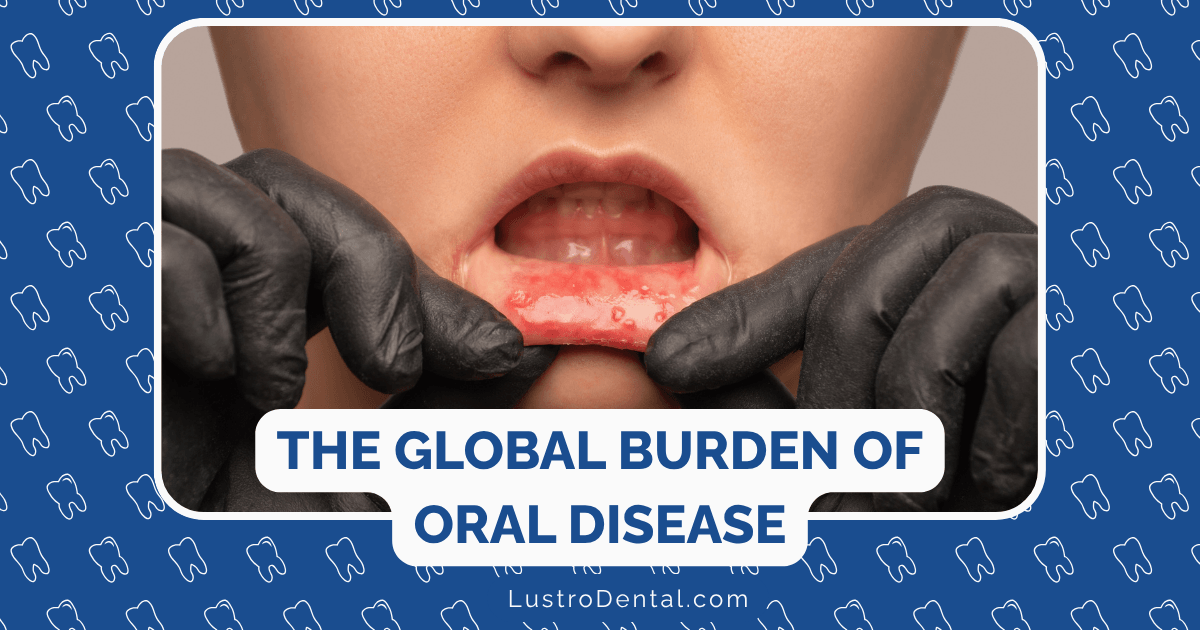The Global Burden of Oral Disease: Understanding Disparities

Oral health is a fundamental component of overall wellbeing, yet it remains one of the most neglected areas of global public health. While many of us take regular dental checkups for granted, the reality is that oral diseases affect nearly half of the world’s population—approximately 3.5 billion people—with profound disparities in who bears this burden and who has access to care. Let’s explore the global landscape of oral health disparities and what can be done to address this critical public health challenge.
The Scale of the Problem: Staggering Numbers
According to the World Health Organization (WHO), the global burden of oral diseases is immense and growing:
- 3.5 billion people worldwide are affected by oral diseases
- Untreated dental caries affect 2.5 billion people globally
- Severe periodontal disease impacts 1 billion people
- Complete tooth loss affects 350 million people
- Oral cancer is diagnosed in 380,000 people annually
What’s particularly alarming is that the estimated number of oral disease cases has increased by approximately 50% during the past 30 years. The Global Burden of Disease Study 2021 indicates that there were 643.3 million prevalent cases of oral disorders globally in 2021, a 17.1% increase from 549.2 million in 1990.
The Economic Burden: Costly for Individuals and Systems
The financial impact of oral diseases is substantial:
- Over $380 billion is spent annually on treating the main oral diseases
- Oral diseases represent approximately 4.8% of global direct health expenditures
- In many countries, treatment of oral diseases is among the most expensive healthcare services
- Dental treatments often require out-of-pocket payments, creating significant financial barriers
According to research published in the Journal of Dental Research, these costs are expected to continue rising as populations age and as developing countries adopt Western diets high in sugar, leading to increased rates of dental caries.
Geographic Disparities: A Tale of Inequality
The burden of oral disease is not distributed equally across regions:
High-Income Countries
- Lower overall prevalence of untreated oral diseases
- Better access to preventive services
- Higher rates of dental visits
- More dentists per capita (approximately 1:2,000 population)
Low and Middle-Income Countries
- Higher prevalence of untreated oral diseases
- Limited access to preventive services
- Lower rates of dental visits
- Critical shortage of oral health professionals (as low as 1:150,000 in parts of Africa)
Recent data from the Lancet shows that the African and Eastern Mediterranean regions have experienced the largest increases in prevalent cases and disability-adjusted life years (DALYs) for most oral conditions. Meanwhile, the European region is the only one to see a decrease in the age-standardized prevalence of untreated caries from 1990 to 2021.
Socioeconomic Disparities: The Social Gradient in Oral Health
A clear social gradient exists in oral health, with disadvantaged groups bearing a disproportionate burden:
Income and Education
- Individuals with lower incomes have 2-3 times higher rates of untreated decay
- Adults with less than a high school education have nearly 3 times more untreated decay than those with higher education
- In many countries, the poorest adults are 40-50% less likely to visit a dentist compared to the wealthiest
Insurance Coverage
- Lack of dental insurance is a significant barrier to care
- In the United States, approximately 74 million people have no dental coverage
- Even in countries with universal healthcare, dental services are often excluded or only partially covered
Urban vs. Rural Disparities
- Urban areas typically have higher concentrations of dental providers
- Rural communities face geographic barriers to accessing care
- In developing countries, oral health services are primarily available in urban centers with little emphasis on preventive care
Research from the National Center for Biotechnology Information indicates that these disparities are not merely differences but inequities—they are unnecessary, avoidable, and unjust, reflecting unequal opportunities for health among disadvantaged groups.
Vulnerable Populations: Those Most Affected
Certain populations face particularly high burdens of oral disease and barriers to care:
Children
- Dental caries is the most common chronic childhood disease
- In some low-income countries, more than 90% of caries in primary teeth remain untreated
- Children living in poverty are 5 times more likely to have untreated dental caries
Elderly
- Approximately 30% of adults aged 65 and older have lost all their natural teeth in some regions
- Edentulism (complete tooth loss) significantly affects nutrition and quality of life
- The elderly often face multiple barriers to dental care, including mobility issues, financial constraints, and lack of transportation
Indigenous Populations
- Indigenous communities often face higher rates of oral diseases
- In many American Indian and Alaska Native communities, factors such as geographic isolation and low income exacerbate oral health disparities
- Despite theoretically free dental care in some regions, actual access remains limited
People with Disabilities
- Individuals with disabilities face unique challenges in accessing dental care
- Many dental facilities are not physically accessible
- Dentists may lack specialized training to treat patients with certain conditions
Root Causes: Understanding the Drivers of Disparities
To address oral health disparities effectively, we must understand their underlying causes:
Limited Access to Care
- Shortage of providers: Many regions face critical shortages of dental professionals
- Geographic barriers: Dental services are often concentrated in urban areas
- Financial barriers: High costs and limited insurance coverage restrict access
Social Determinants of Health
- Income inequality: Lower-income individuals have fewer resources for both preventive and restorative care
- Educational disparities: Lower health literacy affects understanding of oral health importance
- Housing and environment: Living conditions can affect access to clean water for oral hygiene
Healthcare System Factors
- Fragmentation: Separation of oral health from general healthcare systems
- Limited public funding: Many countries allocate minimal resources to oral health
- Focus on treatment over prevention: Most systems emphasize curative rather than preventive approaches
Cultural and Behavioral Factors
- Dietary patterns: Increasing consumption of sugary foods and beverages
- Tobacco and alcohol use: Major risk factors for oral diseases
- Oral health beliefs: Cultural attitudes toward dental care and tooth preservation
Success Stories: Models for Reducing Disparities
Despite these challenges, several approaches have shown promise in reducing oral health disparities:
Community Water Fluoridation
- Recognized as one of the greatest public health achievements of the 20th century
- Reduces tooth decay by approximately 25% in children and adults
- Benefits all residents regardless of socioeconomic status
- Highly cost-effective, saving an estimated $32 for every $1 invested
School-Based Programs
- School dental services reach children regardless of family income or insurance status
- Preventive services like sealants and fluoride varnish can be delivered efficiently
- Integration of oral health education into school curricula improves knowledge and behaviors
Integration with Primary Care
- Training primary care providers to perform basic oral health assessments
- Co-location of dental services with medical care
- Coordinated referral systems between medical and dental providers
Mobile and Teledentistry
- Mobile dental clinics bring care to underserved communities
- Teledentistry expands reach through remote consultations and triage
- Particularly effective for rural and remote populations
The Way Forward: Strategies for Action
Addressing global oral health disparities requires a comprehensive approach:
Policy Level
- Universal health coverage that includes essential oral health services
- Workforce development strategies to increase the number and distribution of oral health providers
- Sugar policies including taxation of sugar-sweetened beverages and food labeling
Healthcare System Level
- Integration of oral health into primary healthcare
- Task-shifting to allow mid-level providers to deliver basic dental services
- Value-based care models that reward prevention and outcomes
Community Level
- Community-based participatory research to understand local needs and resources
- Cultural competency training for oral health professionals
- Community health worker programs to bridge gaps between communities and formal healthcare systems
Individual Level
- Health literacy initiatives to improve understanding of oral health importance
- Self-care support including access to appropriate oral hygiene products
- Patient navigation services to help individuals access available care
The WHO Global Oral Health Action Plan: A Framework for Progress
In response to the global oral health crisis, the World Health Organization has developed a comprehensive Global Oral Health Action Plan with ambitious targets, including a 10% reduction in the prevalence of oral conditions by 2030. The plan emphasizes:
- Oral health promotion and oral disease prevention
- Reorientation of health services toward primary healthcare and universal health coverage
- Strengthening workforce capacity for oral health
- Monitoring, surveillance, and research for oral health
According to the WHO Global Status Report on Oral Health, achieving these goals will require political commitment, adequate resources, and multisectoral collaboration.
Conclusion: A Call to Action
The global burden of oral disease represents one of our most significant yet underrecognized public health challenges. The stark disparities in who suffers from oral diseases and who has access to care are not merely differences—they are inequities that reflect broader social, economic, and political factors.
Addressing these disparities requires action at multiple levels, from global policy to local community initiatives. It demands the engagement of not only dental professionals but also policymakers, public health officials, educators, community leaders, and individuals.
As we work toward a world where everyone has the opportunity for good oral health, we must keep in mind that oral health is not a luxury—it is a fundamental human right and an essential component of overall health and wellbeing. By understanding and addressing the complex factors that drive oral health disparities, we can move closer to a future where the burden of oral disease is both reduced and more equitably distributed.
What steps do you think are most important for addressing oral health disparities in your community? Share your thoughts in the comments below.







